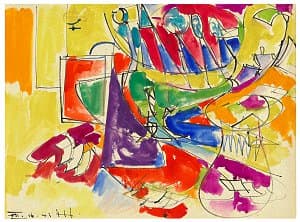

Hans Hofmann
Learn moreUntitled 1943
© Renate, Hans & Maria Hofmann Trust. ARS/Copyright Agency Purchased 1980
More detail | PermalinkThe brilliant colouring and freely expressive forms of Untitled 1943 disguise the sophistication and development of Hans Hofmann’s style after moving to the United States in 1932. Even more than other emigrés, Hofmann brought with him a vast knowledge of avant-garde styles and practices, evident in his history and friendships in Germany and France in the first decades of the twentieth century. Hofmann studied art in Munich and Paris, where he was acquainted with artists such as Henri Matisse, Pablo Picasso and Georges Braque. Hofmann left Paris just before the outbreak of war in 1914, and stayed in Munich for the duration. There he was a friend of Wassily Kandinsky’s partner Gabriele Münter. After Kandinsky was expelled as an enemy alien and returned to Moscow, Münter asked Hofmann to look after his paintings until they could be retrieved after the war.
Such exposure to the most important abstract artist of the time, especially his lyrical Compositions and Improvisations, has a legacy in Hofmann’s work that can be seen in Untitled. Sheer energy is released by a large field of yellow watercolour overlaid by dynamic lines of brush and ink. Curved yellow and green shapes swoop from the upper right, and break into an opposing broken path that reaches down into the lower right. The intensity of colour is partially offset by the semi-transparent medium of watercolour, and Hofmann’s artful placement of almost pure blocks of paint side-by-side. Rectangles of orange and red are counterpointed by violet and blue triangles and circles, becoming a whole that forms a powerful, joyously agitated landscape.
Michael Lloyd and Michael Desmond[i]
[i] Adapted and updated from Michael Lloyd and Michael Desmond, European and American Paintings and Sculptures in the Australian National Gallery 1870–1970, Australian National Gallery, Canberra, 1992, pp 306–7, by Christine Dixon.

